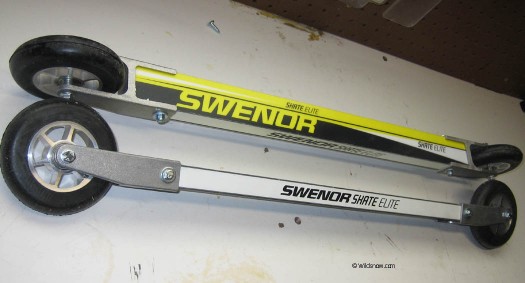“Scott, you gotta get some of these man,” the conversation began.
“No way, its bad enough I get lumped in with the nordies during the winter… I’m not carrying that through the summer!”
“I’m telling you, you are going to love it,” my friend persisted. “Your wife will totally love these things….AND you guys can do this together.”
Okay, hmmm… how can I ignore that one? So I started to think, now that the hook was embedded deeply into my cheek, that maybe I’ll just buy her a pair, and then I could just sneak out when no one is looking and try ’em.
“Alright, order up two pair, besides I can always sell ’em if I hate ’em.”
A month or so later, “they” showed up. Who are “they?” “They” are some Swenor Skate Elite roller skis. Okay, I know where most of you’re minds just went. Visions of old guys in lycra looking dorky on the bike path. That’s where my mind went when I unsuccessfully tried to avoid ordering up these geek sticks. But truth be told, when I saw them up close, I was pretty intimidated and thoughts of slapping onto the asphalt, like in my skateboarding days, didn’t help the picture at all. “Honey, have we met our deductible yet?” Visions of the video below filled my gullible brain, check it out….
Undeterred by these Amazing Race contestants, I decided to crack open the boxes that contained our own wheels of death and get on with the binding install. Being the romantic that I am, I let my wife be the guinea pig on this escapade, so her skis were mounted first.
I started the install by looking at where Swenor recommends the bindings should be placed on the ski. Since I had a few Salomon Equipe Pilot skate bindings lying around, I used the balance point for that binding, which was about 31 cm from the end of the ski (see Swenor’s drawing in previous link to see what I mean here). If you have a bigger boot size or use an NNN binding (I wear a 8.5 US in a Salomon boot) then your balance point will be slightly different, see Swenor’s instructions. Or you could mount the bindings so the heel of your boot can be used as a brake system. Just kidding.

Once you've marked the balance point, just line up the binding slot (where you click into the binding) with the balance point that you carefully measured and marked on the ski, clamp or tape down the binding so it doesn't move, and center-punch the front-most hole. A third hand coming out of your chest would be helpful here.
Since I didn’t have a jig (and they aren’t always perfect anyways…), and I’m used to installing cross country ski bindings, I’m comfortable free handing these installs (although in the shop where I work in the winters, I’d use a jig, carefully, as doing so is way faster). But if you don’t have access to a shop nor a jig then just be careful (or just get a shop to drill them), double check your measurements and go slowly. Once I marked the topsheet of the ski with the centerpunch, (using the binding hole itself as a reference/guide) I used a 3.6mm bit to drill the actual hole for the screw. Then I tapped the hole, screwed in the front-most toe hole, and repeated the process on the next holes.
Key thing is getting the balance point marked where you want it and lining up the binding accordingly. And then just take your time and make sure the binding stays centered on the ski when drilling the rest of the holes. If you don’t keep it centered it is possible (especially with Salomon boots) that the sole of the boot won’t line up with the rear of the binding, and that is really annoying while skiing.
Once you have drilled and tapped the binding holes, epoxy, and screw your bindings down. Swenor advises using a two part epoxy. I use gorilla glue, and it seems to work fine.
So now that I’ve drilled the skis, they are pretty much mine, so I figured that I should give them a chance, or being the unselfish guy that I am, maybe I should let my wife have first tracks? Yep, let’s see how she does.

Jenny skating up the trail. She looked infinitely better than those poor Amazing Race folks. And better yet, her bindings didn't fall off. I was happy.
And then it was my turn. We went down to the local bike path, which is all asphalt, and was conveniently closed in one long section (which means less people/bike traffic, aka hecklers) and I clicked in for the first time. I felt like a clown on the high wire at first, somewhat wobbly looking I’m sure. Having weak ankles from not having skied since last April, and just being plain scared of slapping the pave, didn’t help. But once I started double poling and getting used to how the skis ran it wasn’t too bad.
Getting comfortable with the stopping issue is a little unnerving, but necessary. The hardest thing is keeping in mind that you just don’t stop quickly in these things. You have to anticipate when you want to stop by slowing down and coasting to a stop, or use a funky step snowplow technique or just veer off the bike path into the gravel, grass, barbed wire fence, or what have you.
After a few minutes of feeling and probably looking stiff, uncoordinated and nervous, I began to relax, breathe and sort of enjoy it, at least double poling anyways. I found that going uphill was easier, because you could control your speed more easily, and that allowed me to relax enough to try some V1 and V2 alternate technique and even, dare I say, some V2.
My first impressions of roller skate skiing are that it is a pretty good simulation of the real thing but also at the same time, different. You seem to use the same muscle groups, techniques, and balance but you’re still rolling on asphalt, not sliding on snow. I found myself being a little more mentally on edge (i.e. having a bit of a pucker factor) because of the asphalt–similar feeling to when you are skiing in icy, frozen track conditions in the winter.
What I really like about it is simply using my upper body. Double poling is a great workout in and of itself. And being a road/trail runner, cyclist and hiker in the summer and fall where my upper body basically atrophies, roller skiing should really help slow down that part of the aging process. I know some people that primarily use them just to double pole for that reason.
The Swenor Skate Elites are really pretty comfortable, no buzz from the pavement. They feel pretty forgiving actually, sort of similar to how a skate ski would flex, but they don’t feel like they unload quite like a skate ski. Then again I’m new to this sport so I’m not powering down the bike path. But the “pop” definitely feels like it is there if you want it. And the factory sends the ski with a wheel/bearing combo that aren’t super fast, so there is a bit of resistance built into how fast the ski rolls (you can buy faster or slower wheels / bearings if you feel the need to keep up with the cyclists…or just want more resistance).
You can use all of your existing skate gear to start doing this, with the exception of your skis of course, and you’ll want to swap in a special pole tip like these here. And you want to keep those tips sharp so you get some purchase when you go to plant them in the asphalt. We have used our existing winter pole tips (called ferrules), which work, but are much less durable than replacement tips.
If you’re brand new to the sport, i.e. you’ve never skate skied at all, then you might think about starting out on some classic roller skis, which have lower and wider wheels and should be a bit easier to balance and roll on.
So bottom line, I’m glad I gave in to my friend’s sale pitch. What’s really funny, is that I’ve been out rolling more than my wife, which may or may not be so good for our marriage…It’s always challenging to learn something new (especially when you’re searching for your new prime in life), but totally worth it in the end. I’ve had a few curious stares from others out on the bike path, but no heckling. And its nice to be engaging different muscle groups for a change. I think it will complement running and cycling really well, as long as I stay on my feet and don’t break anything. Though I should still check to see if my deductible is met just in case. Roll, baby roll……
Check out some footage of real skate skiers:
Get out of the way if you see one of these girls rolling up behind you.
At least a few nordies lurk around Wildsnow, and skate skiing wouldn’t hurt the training regimen of any backcountry skier, so please chime in with some comments about your experiences or thoughts on roller skiing. And by the way, roller skiing can be a lycra-free sport. I wear my baggies, so there….
(WildSnow.com guest blogger Scott Nelson and his wife Jenny live in and enjoy the mountain life around Carbondale, CO. You’ll find Scott out running, skiing, climbing, cycling, and whatever else he can do to stay healthy.)
Scott lives near Carbondale, CO with his wife Jenny. He often meditates on finding that perfect career while pushing his heart rate to places it probably shouldn’t be.



